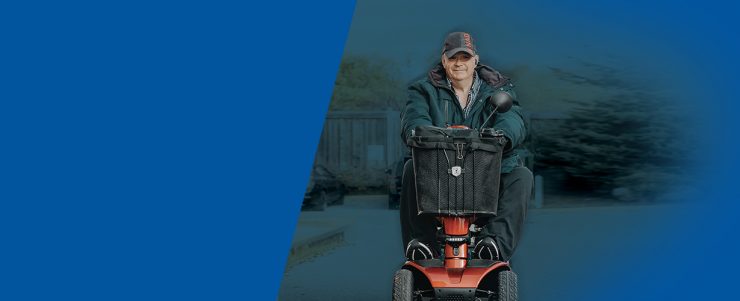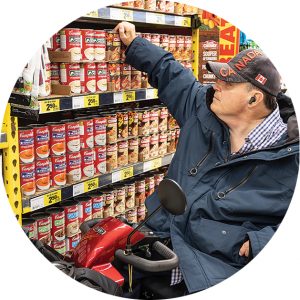Injured in 1996, he sustained a spinal cord injury that also limits the use of his hands. The right equipment makes all the difference to how he has lived his life post-injury. Spinal Cord Injury Ontario has been there to help him from the beginning.
“I was at Lyndhurst for nine months and had to learn everything from transfers to accessing housing and equipment. SCIO got me all my equipment and I’ve been living independently ever since,” he shares.
Still, consistent access to appropriate equipment continues to be a challenge for Frank and many others who require mobility devices. Frank has used various types of wheelchairs for the last 25 years, including manual and powered wheelchairs. While both provided some independence and access to the community, they proved limiting in executing certain activities such as shopping for groceries and carrying items home. “I had a scooter in the past and was able to do my own shopping. With a manual chair, you can’t carry things as easily.” However, the scooter broke down during the pandemic, making it difficult to shop. He had to depend on his PSWs to complete his shopping for him which would cut into his support time. Also, negotiating his neighbourhood in the snow with his wheelchair was difficult. “I was shut in all the time and it felt very isolating.”
“Now, I have this huge basket and I could scoop all the stuff I need and even put it on the counter when I’m checking out. I also sit higher up…So I can reach things.”
Having heard of various funding programs throughout the province, he put in several applications to obtain a scooter, but was unsuccessful. SCIO was able to assist through our Equipment for Independence Program. The program was created to fill in the gaps in current funding models for assistive devices and equipment, after so many in the community shared the challenges of everyday life without appropriate equipment. Funded through donations and fundraising initiatives the program assists people who need equipment but are unable to obtain them because the item is not covered by current ADP models, or they are short the co-pay for approved items.
“I knew someone who was selling a scooter, but I needed the funds,” Frank shares, “SCIO helped make it happen.”
Since getting his scooter in the winter, Frank’s life has changed tremendously. Living in Ajax, he is in a central location that is close to shops, cafes and friends. He is now fully equipped to participate in activities that were simply not possible prior to having a functioning scooter. “Before this, when my PSWs were unavailable, I had to make multiple trips to shop for groceries, because I could only carry a few things at a time.” This increased his risk to exposure to COVID. “Now, I have this huge basket and I could scoop all the stuff I need and even put it on the counter when I’m checking out. I also sit higher up,” he says, “So I can reach things.”
“My activities are possible because of my equipment and SCIO.”
Frank delightfully shares that the scooter even gets him smoothly through snow, unlike his previous modes of mobility and has additional safety measures. “The scooter is equipped with lights, so it’s great in the dark and helps me be seen. My scooter is my pickup truck,” he jokes, reflecting on cruising by the lake knowing he will not get stuck. It also helps him treat his friends to a warm beverage on crisp mornings as he can carry multiple cups of coffee in his basket.
Although Frank, like many in the community, did not know about SCIO’s EIP Program, the benefits have been life-altering, providing a sense of confidence, community, safety and independence. “My activities are possible because of my equipment and SCIO.”








